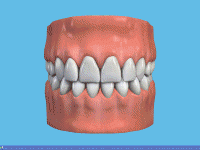Once decay is removed from a tooth, a cavity remains which needs filling up with something in order that food doesn’t stick in the cavity left behind. Different materials can be used – the strongest being dental amalgam, but white fillings, made from types of tough plastic can also be used though these are usually considered to be cosmetic. White fillings, although popular with some people, have never been considered to be as strong as amalgam fillings, especially in locations where they are subject to loading during chewing e.g. on back teeth. It is routine to use white fillings on front teeth where there is less pressure loading.
(See also notes about amalgam toxicity below)
Indirect technique

(Gold) Inlay Preparation
Most cavities are filled using a direct technique i.e. there is a cavity so we will fill it with a material at the same time.
It is also possible to place a filling by an indirect technique, when decay is removed and an impression taken of the cavity. A filling is made in a laboratory and then cemented in the cavity. Such a filling is called an inlay and can be made of gold or extra toughened plastic filling material. These take two visits to place and a temporary filling is in the tooth for a time between visits.
Inlays are suitable for particularly large fillings
Amalgam toxicity
While there is a debate about the safety of mercury – which is chemically bound to other chemicals -in dental amalgam, many authoritative scientific bodies have consistently found no evidence of concern, and that the trace levels of mercury all around us including fish, like tuna, are not at levels which cause any adverse effects.






